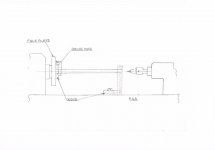Regarding the skew....i seem to have completely misinterpreted the nature of those shiny surfaces in a 2D video. No skewing action there, nideed, i had to re watch it...
And yeah, i will try it out. But first i have to build a new drive unit for my microlathe (not chinese, mind ya, a lil woodwoorking and graver work lathe i built last christmas, size of a watchmakers lathe).
Got a nice 250W resistance start (no capacitor, but huge inrush current, only on small motors up to 1/3 hp or so) 1-phase induction motor from the 40s or 50s. Finally got around to pulling it apart a few days ago. Today i cleaned and regreased the bearings, not its time for reassembly and painting.
Gonna build a small tabletop line shaft. We have a watchmakers lathe too, which is in damn bad shape, but i guess it can be made to do some work. And id love to have a lapping wheel for gravers and gouges. And since low power motors are huge compared to multi hp ones....id rather build a set of shafts than deal with another 30lbs of completely unnecessary motors to run those lil things.
I found a nice catalog image somewhere of an antique lineshaft style set of counterhshafts meant for exactly this purpose.....time to build another one after maybe 70 years have passed....
Did i mention its gonna look cool?

I also hope that the capacitor start induction motor i shot for 11 bucks , shipping included, finally arrives. Boy, that guy is SLOW. Well ok not really. Its just that most ebayers take only 3-4 days to have the shit delivered to your door....and he already needed like 9 to not get it shipped.
Alas, perhaps he just aint got online banking and lives in the middle of nowhere....he has no bad stuff in his ratings...
Edit: Just checked, no, he had it shipped on the 22nd. Some unions are on strike currently....but i dont think postal and shipping guys are......
Weird...
Another motor ? Yeah, it was so cheap and its also vintage. Gonna build a second set of shafting if the first one works. Just because we have a lot of small stuff at the museum which could use one.....


 I've done it.
I've done it.

